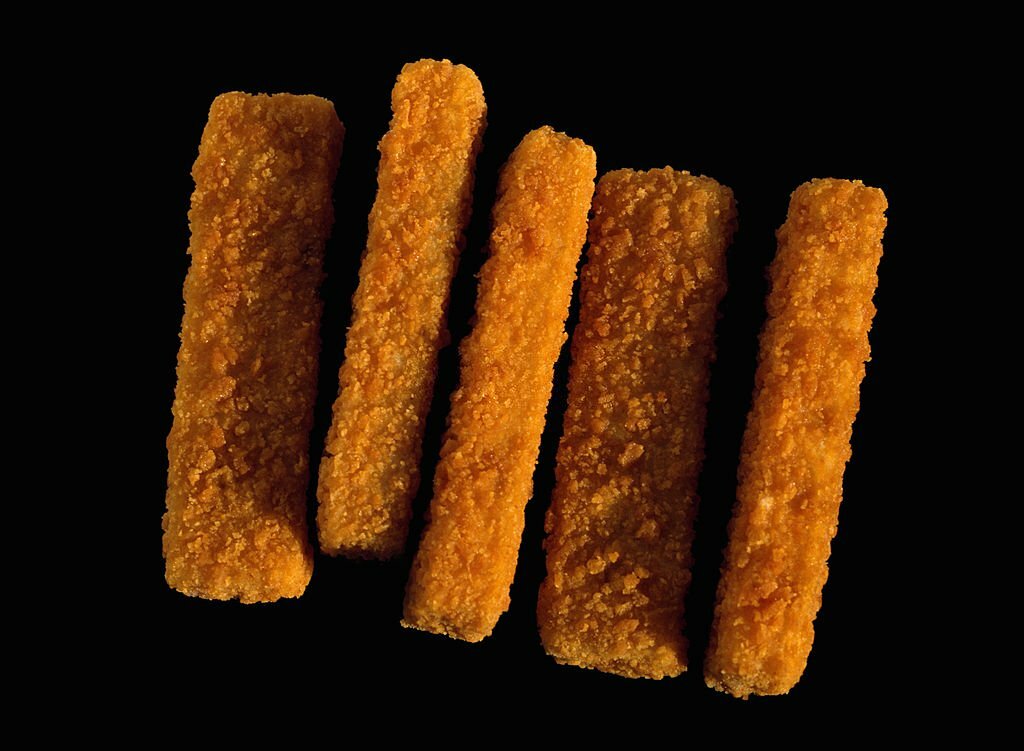Can Dogs Eat Fish Sticks?

Table of Contents
Can Dogs Eat Fish Sticks? Fish sticks can make a quick, convenient meal for humans. But can you safely toss your dog one too? Let’s dive in and find out.
What Are Fish Sticks?
Fish sticks, also sometimes called fish fingers, consist of white fish fillets that have been breaded or battered and then cooked. Popular types of white fish used include cod, haddock, and pollock. The fish is cut into strips or chunks before being coated in flour and breadcrumbs or tempura-style batter. Then the sticks are deep-fried, baked, or pan-fried until golden brown and crispy.
Fish sticks provide humans with a handy source of protein, omega-3s, and other nutrients from fish in a quick and easy-to-eat format. But just because they are nutritious for people does not mean fish sticks are necessarily a healthy choice for your canine companion.
Are Fish Sticks Safe For Dogs To Eat?
Fish on its own is a healthy source of protein and omega-3 fatty acids for dogs. However, the added ingredients in fish sticks, such as the breading, seasonings, salt, and preservatives, may cause some concerns and possible gastrointestinal upset for dogs.
The answer to whether dogs can safely eat fish sticks is not necessarily a straight yes or no. Instead, it depends on the specific ingredients, serving size, and individual tolerances of your dog. Highly seasoned fish sticks or those cooked in a lot of oil are more likely to cause problems. But for dogs that tolerate small amounts of oil and breading well, plain fish sticks may be okay in moderation.
Nutritional Value of Fish for Dogs
Fish is a beneficial part of a dog’s diet because it provides:
- High-quality protein – To maintain and repair muscles
- Omega-3 fatty acids – For healthy skin, coat, joints, heart, and brain
- Vitamins and minerals – Such as Vitamins A, D, E, and B vitamins. As well as iron, selenium, zinc, magnesium, and potassium
Potential Benefits of Fish for Dogs
Due to its excellent nutritional profile, adding fish to your dog’s diet can provide many health benefits including:
- Healthy skin and a shiny coat – Omega-3s support skin and coat health
- Brain development and function – DHA, an omega-3, is a building block for the brain
- Joint health and mobility – EPA, another omega-3, reduces inflammation
- Heart health – Omega-3s are linked to better cardiovascular health
So fish itself offers valuable nutrition for dogs. But do fish sticks provide the same benefits? Let’s look at what’s actually in them.
What’s in Fish Sticks?
Fish sticks contain the following main components:
- Whitefish – Most often pollock, cod, or haddock fillets
- Batter or breading – Usually a flour and breadcrumb coating or tempura-style batter
- Seasonings – Onion powder, garlic powder, salt, spices, etc may be added
- Preservatives – Such as citric acid, calcium propionate, or sodium tripolyphosphate
The white fish itself is nutritious for dogs. However, some of the other ingredients may present problems for canines. Next, let’s look at each one in more detail.
Are the Ingredients Safe for Dogs?
Fish
The fish fillets used in fish sticks provide protein, omega-3s, vitamins, and minerals making them a healthy part of your dog’s diet. Lean white fish is usually well-tolerated by dogs. Just be sure to cook it thoroughly first to kill any bacteria or parasites.

Breading/Batter
The breading or batter coating gives fish sticks their crispy, crunchy texture. However, all that starch and carbohydrate is hard for dogs to digest. Too much can lead to:
- Gastrointestinal upset – Diarrhea or vomiting
- Empty calories – Dogs can gain weight from the extra carbs
So, while an occasional fish stick probably won’t harm your dog, too much of the fried batter or breading can cause issues. Also, if the coating contains garlic or onion powder, it could be toxic.
Seasonings
Many brands of fish sticks contain added flavorings, especially salt, pepper, and other spices. These seasonings can irritate your dog’s stomach and even be dangerous in high amounts, such as:
- Garlic – Can cause oxidative damage to red blood cells leading to anemia
- Onion – Destroys red blood cells and can cause vomiting and diarrhea
- Excessive salt – Leads to sodium ion poisoning and neurological symptoms
Checking the ingredients list and choosing plain, unseasoned varieties is best for dogs.
Preservatives
Fish sticks also contain chemical preservatives such as citric acid, sodium tripolyphosphate, and calcium propionate to extend shelf life. While these are considered safe for human consumption, some dogs may have sensitivities or allergies to these additives.
Risks of Feeding Dogs Fish Sticks
While the fish itself is healthy, some potential risks of feeding fish sticks to dogs include:
- Nutritional imbalance – Too much starch and sodium from the coating and seasonings
- Weight gain – The high calories and fat content can lead to obesity
- Allergic reactions – Dogs may be allergic to the breading, seasonings, or preservatives
- Gastrointestinal problems – The high-fat food can cause vomiting, diarrhea, or pancreatitis
To avoid these issues, feed fish sticks only occasionally and monitor your dog for any signs of intolerance. Only choose plain, lightly breaded varieties with minimal seasonings.
How to Feed Fish Sticks Safely
If you want to share a few bites of your fish stick dinner with Fido, here are some tips to do so safely:
- Choose plain, unseasoned varieties with minimal breading
- Limit the quantity to a few small pieces
- Cook thoroughly to kill any bacteria in the fish
- Watch for signs of intolerance like vomiting or diarrhea
- Avoid giving to dogs with food allergies or sensitivities
Serving a few pieces of plain cooked fish sticks once in a while is unlikely to harm most healthy dogs. But they should not make up a routine part of your dog’s diet. Instead, consider healthier fish-based options.
Healthier Fish-Based Options for Dogs
For a tasty fish treat your dog will love, try these healthy alternatives to fish sticks:
- Canned fish like salmon or sardines – Provides omega-3s without added breading or seasoning
- Plain cooked fish like cod, trout, or tilapia – A quick protein boost without the excess fat and carbs
- Fish oil supplements – The safest way to provide omega-3 benefits without the risk of allergies
Feeding whole, unseasoned fish or oil lets your dog reap the benefits of fish without the additives found in fish sticks. Always introduce new foods gradually to check for allergies.
Related: can dogs eat bean sprouts

Homemade Dog-Friendly Fish Sticks
If you want to make a homemade version of fish sticks for your pup, try this recipe:
Ingredients:
- 1 lb firm white fish fillets like tilapia or cod
- 1 cup whole wheat flour
- 1 egg
- 1⁄4 cup plain Greek yogurt
- 1⁄2 cup panko breadcrumbs
Instructions:
- Cut fish into strips or chunks and pat dry.
- Place flour in one bowl, lightly beaten egg and yogurt in another, and panko in a third.
- Coat each piece of fish in flour, then egg mix, then panko.
- Place on a lightly greased baking sheet.
- Bake at 425°F for 10-12 minutes until crispy and fish is cooked through.
- Let cool before serving it to your pup!
This provides a crunchy treat they’ll love without unhealthy seasonings or excess fat and calories.
When to Avoid Feeding Fish to Dogs
While fish can be beneficial for dogs, there are a couple of situations when it may be best to avoid:
- If your dog has an allergy or sensitivity to fish – Symptoms like itching, upset stomach, or skin irritation may occur. Always introduce new foods slowly.
- Risk of mercury exposure – Some larger, long-lived fish like swordfish and sharks can contain high mercury levels. These are best avoided.
Stick to smaller varieties like salmon, cod, sardines, or tuna to limit mercury risks. And of course, deep-fried fish sticks should only be an occasional treat, not a regular menu item.
Final Words
Fish sticks make an easy people-pleaser. But when it comes to dogs, the added ingredients may not always be paw-approved. While the fish itself provides healthy protein and omega-3s, the breading, seasoning, salt, and preservatives in fish sticks could lead to gastrointestinal upset and other problems in dogs.
In moderation, plain lightly breaded, and baked fish sticks are unlikely to harm your dog. However, for optimal nutrition and health, choose better fish-based options like canned salmon, home-cooked fish, or fish oil supplements. Or whip up some dog-friendly homemade fish sticks for a special treat. Just be sure to monitor your dog for any signs of intolerance. By making wise choices about whether and how to feed fish sticks, you can safely share the benefits of fish with your pup.
Questions and Answers About Dogs and Fish Sticks
Still, have questions about whether dogs can or should eat fish sticks. Here are answers to some common queries:
Q: Can puppies eat fish sticks?
A: Fish can be introduced after weaning, but avoid heavily breaded fish sticks. Plain-cooked fish or canned fish are better for young puppies.
Q: Do dogs like the taste of fish sticks?
A: Most dogs enjoy the flavor of fish. However, the breading may deter some dogs. Try offering plain fish first to see if your dog likes it.
Q: What happens if a dog eats too many fish sticks?
A: Eating too many fish sticks could cause gastrointestinal upset, pancreatitis, or nutritional imbalance. Limit to just a few on occasion.
Q: Can I give my dog leftover fried fish sticks?
A: Avoid feeding dogs heavily fried foods with oil or grease. Bake or pan-fry lightly breaded sticks instead.
Q: Are fish sticks a good treat for dogs?
A: Due to the high carbs and fat, fish sticks are not an ideal regular treat. Try healthy alternatives like dried salmon or sweet potato chews.






